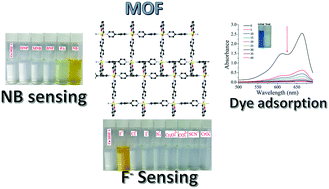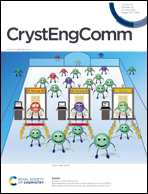A novel sustainable metal organic framework as the ultimate aqueous phase sensor for natural hazards: detection of nitrobenzene and F− at the ppb level and rapid and selective adsorption of methylene blue†
Abstract
Herein, a new cationic Cu(II)-based porous and water stable metal–organic framework (MOF), [{Cu(bipy)1.5(H2pdm)}·2NO3·H2O]n (Cu-MOF-1), is synthesised via a slow evaporation process using pyridine-2,6-dimethanol (H2pdm) and 4,4′-bipyridine (bipy). The MOF is characterized using Fourier-transform infrared (FTIR) spectroscopy, powder X-ray diffraction (PXRD), thermogravimetric analysis (TGA), magnetic analysis and single-crystal X-ray diffraction analysis. The structural unit of Cu-MOF-1 consists of two Cu(II) ions bridged by bipy and supported by H2pdm. This material exhibits excellent sensing ability for nitrobenzene (NB) and fluoride ions (F−) in 100% aqueous medium with an ultra-low limit of detection of 0.093 and 1.203 ppb for NB and F−, respectively. The detection of nitro aromatic compounds (NACs) was found to be governed by photo-induced electron transfer (PET) and fluorescence resonance energy transfer (FRET) mechanisms, while vapour pressure played a major role in NB detection, with a high fluorescence quenching of 96.4%. Moreover, the MOF showed high water stability, significant recyclability and microporosity. The MOF was also employed for the adsorption and separation of methylene blue (MB) from a mixture of three dyes (MB, rhodamine-B and methyl orange). At equilibrium, the removal percentage of Cu-MOF-1 for MB was 98.23% and the mechanism of dye adsorption was also explored. Thus, the present MOF was determined to be a sustainable multifunctional material for the aqueous phase sensing of hazardous NB and fluoride ions, as well as an excellent dye adsorbent.



 Please wait while we load your content...
Please wait while we load your content...